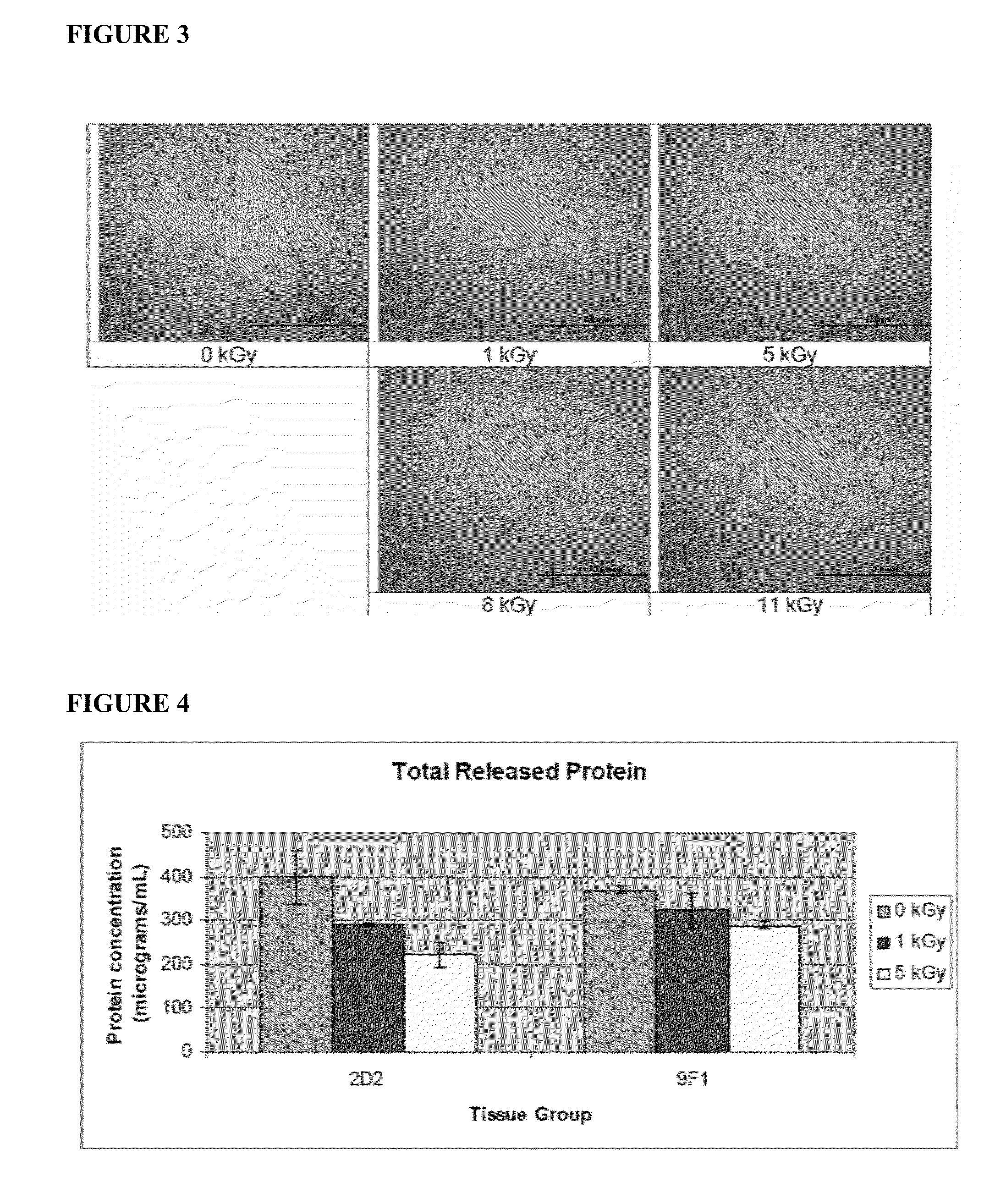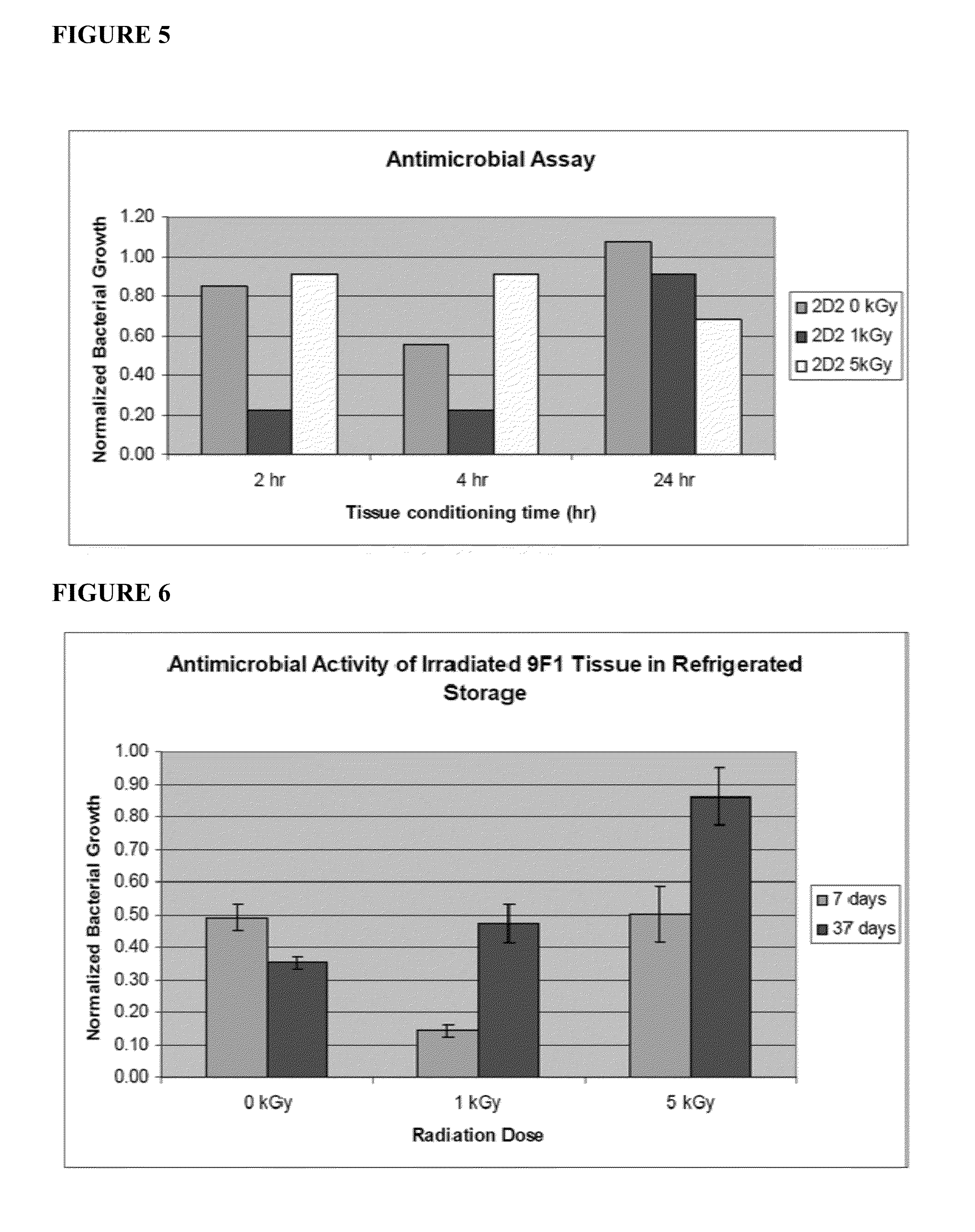Dried and irradiated skin equivalents for ready use
a technology of skin equivalents and irradiation, which is applied in the direction of prosthesis, packaging goods, applications, etc., can solve the problems of inability to effectively and efficiently preserve and store engineered tissues, and inability to achieve long-term storage. , to achieve the effect of preventing tissue movement, increasing radiation dose, and restoring protein accessibility
- Summary
- Abstract
- Description
- Claims
- Application Information
AI Technical Summary
Benefits of technology
Problems solved by technology
Method used
Image
Examples
example 1
[0073]This example describes a method for the production of skin equivalents.
[0074]Media. The organotypic culture process uses three different culture media, all based on the formulation of SMB medium described in U.S. Pat. No. 7,407,805, with the exception that cholera toxin is omitted from all media. FM01 is used to propagate the normal human dermal fibroblasts (NHDFs) for use in skin equivalent dermal equivalent layers. FM01 has the same formulation as SMB except that it contains Fetal Clone II serum (2% final) and lacks cholera toxin. KM01 is used to grow NIKS keratinocytes and has the same composition as SMB except that it contains 2.5% fetal clone II, and additional epidermal growth factor (EGF) is added to a final concentration of 5 ng / ml. SM01 is used during the epidermal stratification phase of skin equivalent production and is identical to SMB except for the omission of cholera toxin.
[0075]Dermal equivalent preparation. On day 0, frozen NHDF cells are thawed and plated. Th...
example 2
Determination of the Lethal Dose of Gamma Radiation Required to Produce Nonviable, Sterile Skin Equivalent Tissue
[0077]The production schedule for development of irradiated skin equivalents was based on the 28-day production process previously established for engineered human skin tissue products. 9F1 and 2D2 tissues, which had been engineered for enhanced expression of the host defense peptides hBD-3 and hCAP18 / LL-37, respectively, were produced using aseptic procedures. Tissues were transferred onto nutrient gel chambers and sealed prior to packaging and transport. Gamma irradiation was performed by Sterigenics, Inc. using the ExCell high precision gamma irradiator, at its Charlotte, N.C. facility. Tissues received one of five radiation doses: 0 kGy, 1 kGy, 5 kGy, 8 kGy, or 11 kGy. These doses were chosen based on previous evaluation of similar doses on allograft tissues. After irradiation, tissues were refrigerated prior to analysis at the times indicated below.
[0078]Upon return ...
example 3
Evaluation of the Structural Properties of Gamma-irradiated Skin Equivalent Tissue
[0084]The structural properties of irradiated tissues after 3 days of refrigerated storage were evaluated by histological staining with hematoxylin and eosin and visualized by light microscopy. Histological staining verified that irradiated tissues retain normal tissue organization and gross morphology. All cellular layers, including dermis, basal and spinous keratinocyte layers, and stratum corneum, were identifiable in nonirradiated control and irradiated tissues, though some tissue damage was apparent at higher radiation doses, visualized as gaps between the dermal and epidermal compartments. As a result, 1 kGy and 5 kGy dose levels were identified as the most promising for use in subsequent studies.
PUM
 Login to View More
Login to View More Abstract
Description
Claims
Application Information
 Login to View More
Login to View More - R&D
- Intellectual Property
- Life Sciences
- Materials
- Tech Scout
- Unparalleled Data Quality
- Higher Quality Content
- 60% Fewer Hallucinations
Browse by: Latest US Patents, China's latest patents, Technical Efficacy Thesaurus, Application Domain, Technology Topic, Popular Technical Reports.
© 2025 PatSnap. All rights reserved.Legal|Privacy policy|Modern Slavery Act Transparency Statement|Sitemap|About US| Contact US: help@patsnap.com



